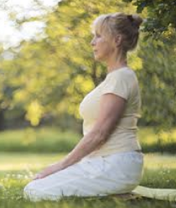Taking Your Seat
Blog post by Lynn Koerbel, MBSR teacher and trainer
Those who’ve been in a class with me know this is my favorite meditation instruction, “Taking your seat.” Here’s why.
When I first encountered meditation, like many, I struggled: Making time, a typical hurdle, wasn’t the issue. No, mine was a subtle but persistent resistance. Even though meditation was something I really wanted to do, wanted to understand, and make a part of my life—some other part of me clearly wanted none of it.
I found all kinds of interesting ways to get myself on the cushion despite this resistance: I would sort of “back” myself into meditation—“trick” myself into getting to the cushion so I’d find myself meditating without knowing how I got there. For instance, I’d roll out of bed, and, eyes half-shut, make my way to the cushion so I didn’t have time or energy to argue with myself. While it worked, and helped me develop some discipline, it also felt like a forced march—not a conducive attitude to cultivate! It wasn’t sustainable—and more, didn’t feel honest. If I was meditating to be awake, then I wanted to at least not have to sleepwalk to my practice!
This all began to shift when I noticed that my teacher’s instructions included many specific suggestions about posture and the body. She took her time in guiding, and as I listened to her voice—and then listened to my body’s responses—I noticed how I felt “gentled” into stillness, wooed almost, through such careful attention to taking my seat.
Exploring this process of approaching practice, here’s what “taking my seat” has come to mean for me: First, it acknowledges that there is an approach, a glide path to the act: A physical preparation to sit (or lie down or stand, if that’s the posture for you). Taking the time to settle, to greet oneself, gives one’s whole being some space and time to get used to the idea of what’s to come. In short: It’s kind.
So for me, the preparation to meditate is part of meditation: Taking my seat means the minute or two or five that I spend stretching or yawning, getting my cushion just right, supporting my left knee the way it likes, settling into my hips, feeling how my chest and shoulders are in relation to my hips, and then, where my spine is, how my head is in relation to all of it—and that span between the groundedness of my seat and the uplift through my spine and the way my arms slope from my shoulders, without strain. And hands? How are my hands? Tense? Or can I feel how their warmth is conveyed to my thighs? All this is taking my seat. In short: it’s generous.

The more I did this deliberately, the more the phrase opened to me. For instance, what is this taking? For me, it’s a fulfillment of my wish to practice. I’m setting my course, acting with conviction. I’m doing it with kindness and generosity, and I do it with my whole body. I’m in alignment with myself.
Interestingly, this approach to meditation influences my life outside of formal practice. Do I take my seat in meetings? When I’m with friends? Am I at home in my body during a stressful conversation? How about when I’m teaching or meeting with colleagues online? How am I “sitting” in relation to all that is happening? Even asking this in the moment brings about a kind and generous curiosity and the invitation to sit more fully in my seat.
This is a fun exploration for me, deepening in surprising ways over the years, and I love hearing how others take their seat, whatever the hurdles. Anyone who practices will meet this sometime or another.
So how do you take your seat?
I look forward to hearing your learnings and insights.
